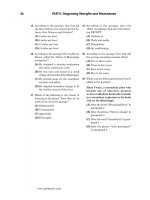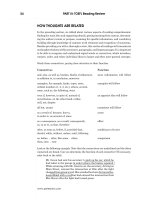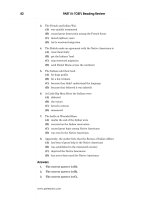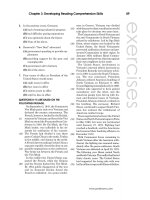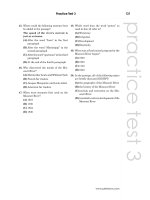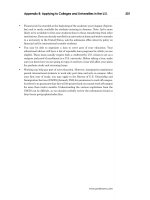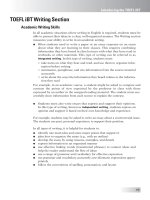READING JAPANESE - PART 5 pps
Bạn đang xem bản rút gọn của tài liệu. Xem và tải ngay bản đầy đủ của tài liệu tại đây (192.89 KB, 16 trang )
READING JAPANESE
六十五
Examples:
—ッパ —ppa —ッバ —bba
—ッピ —ppi —ッビ —bbi
—ップ —ppu —ッブ —bbu
—ッペ —ppe —ッベ —bbe
—ッポ —ppo —ッボ —bbo
ヨーロッパ yooroppa 'Europe'
ミシシッピー misisippii 'Mississippi'
ノッブヒル nobbuhiru
1
'Nob Hill'
ハッピー happii 'happy'
ハッピーエンド happiieñdo 'happy end[ing]'
ハッピーバースデー happiibaasudee 'happy birthday'
アップル appuru 'apple'
アップルパイ appurupai 'apple pie'
パイナップル painappure 'pineapple'
1
Also ノブヒル nobuhiru.
READING JAPANESE
六十六
—ッタ —tta —ッダ —dda
—ッチ —tti
—ッツ —ttu
—ッテ —tte —ッデ —dde
—ット —tto —ッド —ddo
カルカッタ karukatta 'Calcutta'
マンハッタン mañhattañ 'Manhattan'
リッチモンド rittimoñdo 'Richmond'
サンモリッツ sañmorittu 'St. Moritz'
ピッツバーグ pittubaagu 'Pittsburgh'
ロッテルダム rotterudamu 'Rotterdam'
チベット tibetto 'Tibet'
スコットランド sukottorañdo 'Scotland'
バグダッド bagudaddo 'Baghdad'
バット batto 'bat'
バッター battaa 'batter'
バッテリー batterii 'battery'
ユナイテッド・ステーツ・オブ・アメリカ yunaiteddo
・
suteetu
・
obu
・
amerika 'United States of America'
READING JAPANESE
六十七
—ッサ —ssa —ッザ —zza
—ッシ —ssi —ッジ —zzi
—ッス —ssu —ッズ —zzu
—ッセ —sse —ッゼ —zze
—ッソ —sso —ッゾ —zzo
オデッサ odessa 'Odessa'
アッサム assamu 'Assam'
アッシリア assiria 'Assyria'
ゲッセマニ gessemani 'Gethsemane'
ケンブリッジ keñburizzi 'Cambridge'
ハッスル hassuru 'hustle'
バッスル bassuru 'bustle' (clothing)
READING JAPANESE
六十八
—ッカ —kka —ッガ —gga
—ッキ —kki —ッギ —ggi
—ック —kku —ッグ —ggu
—ッケ —kke —ッゲ —gge
—ッコ —kko —ッゴ —ggo
メッカ mekka 'Mecca' ロッキー rokkii 'Rocky [Mountains]'
ケンタッキー keñtakkii 'Kentucky' ブルックリン burukkuriñ 'Brooklyn'
ストックホルム sutokkuhorumu 'Stockholm' モロッコ morokko 'Morocco'
デッキ dekki 'deck' テープデッキ teepudekki 'tapedeck'
ブック bukku 'book' ブックエンド bukkueñdo 'bookend'
ハンドブック hañdobukku 'handbook' スクラップブック sukurappubukku 'scrapbook'
バック bakku 'back' バックアップ bakkuappu 'back-up'
バックストレッチ bakkusutoretti 'back-stretch' バッグ baggu 'bag'
ハンドバッグ hañdobaggu 'handbag' ビッグ biggu 'big'
ビッグゲーム biggugeemu 'big game' ビッグスリー biggusurii 'big three'
ビッグビジネス biggubizinesu 'big business
READING JAPANESE
六十九
ADDITIONAL PRACTICE
1. コップ
2. マッチ
3. モップ
4. モッブ
5. ベッド
6. エッジ
7. バッジ
8. エッグ
9. ホットドッグ
10. クリーン・カット
11. スイッチ
12. スリッパ
13. モットー
14. パッシブ
15. スモック
16. サッカー
17. トイレット
18. ハムエッグ
19. グッドセンス
20. コンプレックス
21. ビスケット
22. ホットケーキ
23. レッツ・ゴー
24. マジック・ドア
25. ニーソックス
26. マジック・アイ
27. ノータックス
28. レッドテープ
29. ダイナミック
30. バックナンバー
1. koppu 'drinking glass'
2. matti 'match'
3. moppu 'mop'
4. mobbu 'mob'
5. beddo 'bed'
6. ezzi 'edge'
7. bazzi 'badge'
8. eggu 'egg'
9. hottodoggu 'hotdog'
10. kuriiñkatto 'cleancut'
11. suitti 'switch'
12. surippa 'slipper'
13. mottoo 'motto'
14. passibu 'passive'
15. sumokku 'smock'
16. sakkaa 'soccer'
17. toiretto 'toilet'
18. hamueggu 'ham [and] egg'
19. guddoseñsu 'good sense'
20. koñpurekkusu 'complex'
21. bisuketto 'biscuit', 'cookie'
22. hottokeeki 'hotcake'
23. rettu・goo 'let's go'
24. mazikku・doa 'magic door'
25. niisokkusu 'knee socks'
26. mazikku・ai 'magic eye'
27. nootakkusu 'no tax'
28. reddoteepu 'red tape'
29. dainamikku 'dynamic'
30. bakkunañbaa 'back number'
READING JAPANESE
七十
31. カセット・テープ
32. ノーヒット・ノーラン・ゲーム
33. ウエスタン・ルック
31. kasetto・teepu 'cassette tape'
32. noohitto・nooran・geemu 'no-hit-no-run game'
33. uesutan・rukku 'western look'
Reduced katakana ツ may also be followed by a syllable with initial h The combination ッフ often
corresponds to the English spelling doublet 'ff', and ッハ, ッヒ, and ッホ approximate the kind of
final sound that occurs in German 'ach', 'ich', and 'och'. Thus:
スタッフ sutahhu 'staff' or 'stuff'
バッハ bahha 'Bach'
ハインリッヒ haiñrihhi 'Heinrich'
バンゴッホ bañgohho 'Van Gogh'
The last three examples are borrowings from languages other than English. Note that in these words,
the vowel following -hh- in the Japanese, which is not present in the original language, is the same
as the vowel preceding the lengthened consonant.
READING JAPANESE
七十一
SYLLABLES CONSISTING OF CONSONANT + y + VOWEL
Examine the following combinations:
キャ ギュ ショ チャ ビュ ピョ
The first katakana symbol in each group represents a syllable consisting of a consonant + i, and the
second, a syllable consisting of y + a vowel
1
. In each case, the second symbol is written slightly
smaller and lower
2
than the surrounding symbols. Such combinations represent single syllables
romanized as consonant + y + vowel.
Thus, ビヤ is equivalent to the romanized two-syllable sequence biya, but ビャ is equivalent to the
romanized single syllable bya.
This writing convention is used for traditional Japanese words as well as recent borrowings into the
language.
1
The only vowels possible are a, u, and o.
2
Further right, in vertical writing.
READING JAPANESE
七十二
Summary of Consonant + y + Vowel Syllables
キャ kya
1
シャ sya
2
チャ tya
3
ニャ nya ヒャ hya ミャ mya リャ rya
キュ kyu シュ syu チュ tyu ニュ nyu ヒュ hyu ミュ my リュ ryu
キョ kyo ショ syo チョ tyo ニョ nyo ヒョ hyo ミョ myo リョ ryo
ギャ gya
4
ジャ zya
5
ビャ bya ピャ pya
ギュ gyu ジュ zyu ビュ byu ピュ pyu
ギョ gyo ジョ zyo ビョ byo ピョ pyo
When the vowel of the consonant + y + vowel syllable is lengthened, the symbol indicating length is
written in line with the symbols of regular size. Thus:
ニュー nyuu 'new'
Note that the consonant + y + vowel combination may be immediately preceded or followed by
reduced ツ, indicating consonant lengthening. Thus:
ネールポリッシュ neeruporissyu 'nail polish'
ショッピング syoppiñgu 'shopping'
1
キャ occurs frequently as a representation of the initial consonant + vowel of English 'cab', alternating with カ ka.
2
Sy combinations (シャ、シュ、ショ) regularly correspond to the initial consonant of English 'show'.
3
Ty combinations (チャ、チュ、チョ) regularly correspond to the initial consonant of English 'chin'.
4
ギャ oocurs frequently as a representation of the initial consonant + vowel of English 'gab', alternating with ガ ga.
5
Like z before i, zy (ジャ、ジュ、ジョ) may correspond to the medial consonant of English 'ledger' or of 'measure'.
READING JAPANESE
七十三
Examples:
チャド tyado
チャッド or tyaddo 'Chad'
キューバ kyuuba 'Cuba'
ヒューロン hyuuroñ 'Huron'
シャンハイ syanhai 'Shanghai
ジョージア zyoozia 'Georgia'
キャンベラ kyañbera 'Canberra'
ジャカルタ zyakaruta 'Jakarta'
バミューダ bamyuuda 'Bermuda'
ニューヨーク nyuuyooku 'New York'
アリューシャン aryuusyañ 'Aleutian' (islands)
マサチューセッツ masatyuusettu 'Massachusetts'
リオデジャネイロ riodezyaneiro 'Rio de Janeiro'
READING JAPANESE
七十四
ADDITIONAL PRACTICE
1. ジュース
2. ニュース
3. チョーク
4. ヒューズ
5. パジャマ
6. ギャップ
7. ギャング
8. ジャンボ
9. レジャー
10. ローション
11. シャンプー
12. ジョーカー
13. ボリューム
14. ヒューマン
15. ピューレー
16. ビューロー
17. ミュージック
18. ピューリタン
19. ヒューネラル
20. プッシュホン
21. バーベキュー
22. ベビーショップ
23. ジャイロスコープ
24. ニュースバリュー
25. コンピューター
26. マッシュルーム
27. キャブレター
28. ニューロチック
29. ヘアローション
30. ユナイテッド・ネーションズ
1. zyuusu 'juice'
2. nyuusu 'news'
3. tyooku 'chalk'
4. hyuuzu 'fuse'
5. pazyama 'pajama[s]'
6. gyappu 'gap'
7. gyañgu 'gang'
8. zyañbo 'jumbo'
9. rezyaa 'leisure'
10. roosyoñ 'lotion'
11. syañpuu 'shampoo'
12. zyookaa 'joker'
13. boryuumu 'volume'
14. hyuumañ 'human'
15. pyuuree 'pure
16. byuuroo 'bureau'
17. myuuzikku 'music'
18. pyuuritañ 'puritan'
19. hyuuneraru 'funeral'
20. pussyuhoñ 'push [button] phone'
21. baabekyuu 'barbecue'
22. bebiisyoppu 'baby shop'
23. zyairosukoopu 'gyroscope'
24. nyuusubaryuu 'news value'
25. koñpyuutaa 'computer'
26. massyuruumu 'mushroom'
27. kyaburetaa 'carburetor'
28. nyuurotikku 'neurotic'
29. hearoosyoñ 'hair lotion'
30. yunaiteddo・neesyoñzu 'United Nations'
READING JAPANESE
七十五
INNOVATIVE PRONUNCIATION
For the representation of sounds and combinations of sounds that occur only in the more innovative
Japanese pronunciation of recent loan words, special conventions for the use of katakana have been
adopted.
1. The combinations テュ、デュ、フュ exemplify the same principle that was described in the
preceding section, i.e., the initial symbols retain their consonantal value but lose their vocalic
value, and the combinations represent unit syllables. They will be represented in our
romanization as t(e)yu, d(e)yu and h(u)yu respectively.
Examples:
テューバ t(e)yuuba 'tuba'
エデュケーション ed(e)yukeesyoñ 'education'
フューネラル h(u)yuuneraru 'funeral'
In the less innovative variety of Japanese, チュ tyu, ジュ zyu, and ヒュ hyu occur instead.
2. A vowel symbol written smaller and lower
1
than surrounding symbols also indicates that the
preceding symbol has its consonant value only. For example, the combination フェ represents
a single syllable consisting of the sound symbolized by the h- of hu + the e vowel. This will be
1
Further right, in vertical texts.
READING JAPANESE
七十六
indicated in romanization as h(u)e. The more commonly occurring combinations in this
category are:
ティ t(ei シェ s(i)e ファ h(u)a
ディ d(e)i ジェ z(i)e フィ h(u)i
トゥ t(o)u フェ h(u)e
ドゥ d(o)u フォ h(u)o
チェ t(i)e
Examples:
ケープ・ケネディー keepu・kened(e)ii 'Cape Kennedy'
チェコスロバキア t(i)ekosurobakia 'Czechoslovakia'
アルジェリア aruz(i)eria 'Algeria'
ナイジェリア naiz(i)eria 'Nigeria'
ファーイースト h(u)aaiisuto 'Far East'
ニューファウンドランド nyuuh(u)auñdorañdo 'Newfoundland'
フィリピン h(u)iripiñ 'Philippine[s]'
フィンランド h(u)iñrañdo 'Finland'
フィラデルフィア h(u)iraderuh(u)ia 'Philadelphia'
READING JAPANESE
七十七
In the less innovative variety of Japanese the following alternations occur:
チ for ティ
ジ for ディ
ツ for トゥ
ズ for ドゥ
チ for チェ
セ for シェ
ゼ for ジェ
ハ for ファ
ヒ for フィ
ヘ for フェ
ホ for フォ
3. The katakana combination クォ occurs in loanwords only, as a representation of the sound
sequence k + w + o. This combination will be symbolized by kwo in romanization.
Example:
ラテンクォーター rateñkwootaa 'Latin Quarter'
In the less innovative variety of Japanese, クオ kuo (i.e., two syllables) occurs instead.
4. When katakana ウ is followed by a reduced vowel symbol ィ、ェ、 or ォ, it is assumes the
consonantal value of the w- of wa. Thus, while ワ is equivalent to romanized wa both in native
Japanese words and loanwords, ウィ, ウェ, ウォ represent wi, we, wo which occur only in
loanwords. In the less innovative variety of Japanese, ウイ ui, ウエ ue, ウオ uo̶all two-
syllable sequences—occur instead. A long u vowel (ウー) continues to be the correspondence
for English 'w' + 'u' (as in 'wool', 'woman', etc.).
READING JAPANESE
七十八
Examples:
ウィンブルドン wiñburudoñ 'Wimbledon'
ウェーク weeku 'Wake'
ミルウォーキー miruwookii 'Milwaukee'
5. Katakana ウ with nigori is used to represent the voiced labiodental
1
'v' which occurs in Japanese
only in loanwords in the more innovative variety of the language. When followed by a reduced
vowel a, i, e, or o, ヴ represents the v only. Without a following reduced vowel, ヴ represents
the syllable vu.
Thus: ヴァ va ヴィ vi ヴ vu ヴェ ve ヴォ vo
In the less innovative variety of Japanese, バ ba, ビ bi, ブ bu, ベ be, ボ bo occur instead of
these special combinations.
Examples:
ヴァチカン vatikañ 'Vatican' ヴァンクーヴァー vañkuuvaa 'Vancouver'
ヴィシー visii 'Vichy' ヴォルガ voruga 'Volga' (river)
サーヴ saavu 'serve'
1
Consonants articulated with the lower lip and the upper teeth.
READING JAPANESE
七十九
6. When katakana イ is followed by a reduced vowel symbol ェ, it assumes the consonantal values
of the y of ya, and the combination represents the syllable ye which occurs only in loanwords.
In the less innovative variety of Japanese, a two-syllable sequence イエ or エー occurs instead.
Example:
イェーメン yeemeñ 'Yemen'
ADDITIONAL PRACTICE
1. ファン
2. フォト
3. フォイル
4. ビュッフェ
5. ヴィデオ
6. ソファー
7. ファション
8. ハイファイ
9. チィーポット
10. フォーマル
11. アイスティー
12. フェアプレー
13. フェンシング
14. ウェイトレス
15. ヨッティング
1. h(u)añ 'fan' (i.e., enthusiast)
2. h(u)oto 'photo'
3. h(u)oiru 'foil'
4. byuhh(u)e 'buffet'
5. video 'video'
6. soh(u)aa 'sofa'
7. h(u)assyoñ 'fashion'
8. haih(u)ai 'hi-fi'
9. t(e)iipotto 'teapot'
10. h(u)oomaru 'formal'
11. aisut(e)ii 'ice[d] tea'
12. h(u)eapuree 'fair play'
13. h(u)ensiñgu 'fencing'
14. weitoresu 'waitress'
15. yott(e)iñgu 'yachting'
READING JAPANESE
八十
16. スパゲッティ
17. カーディガン
18. ヌーディスト
19. クォータリー
20. ヴァイオリン
21. ヴォランティア
22. フォークダンス
23. フェザーウェート
24. フェード・アウト
25. フィールドワーク
26. フィフティフィフティ
27. フォームラバー
28. ディルピックルス
29. ヴォキャビュラリー
30. ファウルスロー
31. ティーンエイジャー
32. サードクォーター
33. ヴァキュームクリーナー
34. フォゲットミーナット
16. supagett(e)i 'spaghetti'
17. kaad(e)igañ 'cardigan'
18. nuud(e)isuto 'nudist'
19. kwootarii 'quarterly'
20. vaioriñ 'violin'
21. vorañt(e)ia 'volunteer'
22. h(u)ookudañsu 'folk-dance'
23. h(u)ezaaweeto 'featherweight'
24. h(u)eedo・auto 'fadeout'
25. h(u)iirudowaaku 'field work'
26. h(u)ihut(e)ih(u)ihut(e)i 'fifty-fifty'
27. h(u)oomurabaa 'foam rubber'
28. d(e)irupikkurusu 'dill pickles'
29. vokyabyurarii 'vocabulary'
30. h(u)aurusuroo 'foul throw'
31. t(e)iiñeizyaa 'teenager'
32. saadokwootaa 'third quarter'
33. vakyuumukuriinaa 'vacuum cleaner'
34. h(u)ogettomiinatto 'forget-me-not'

